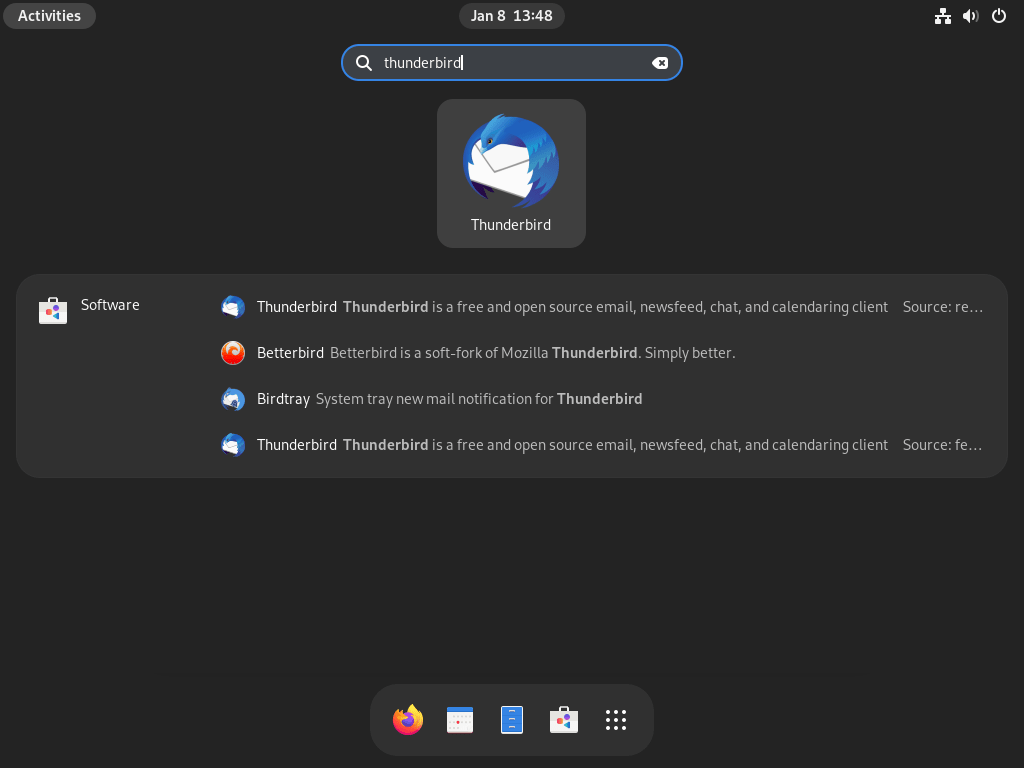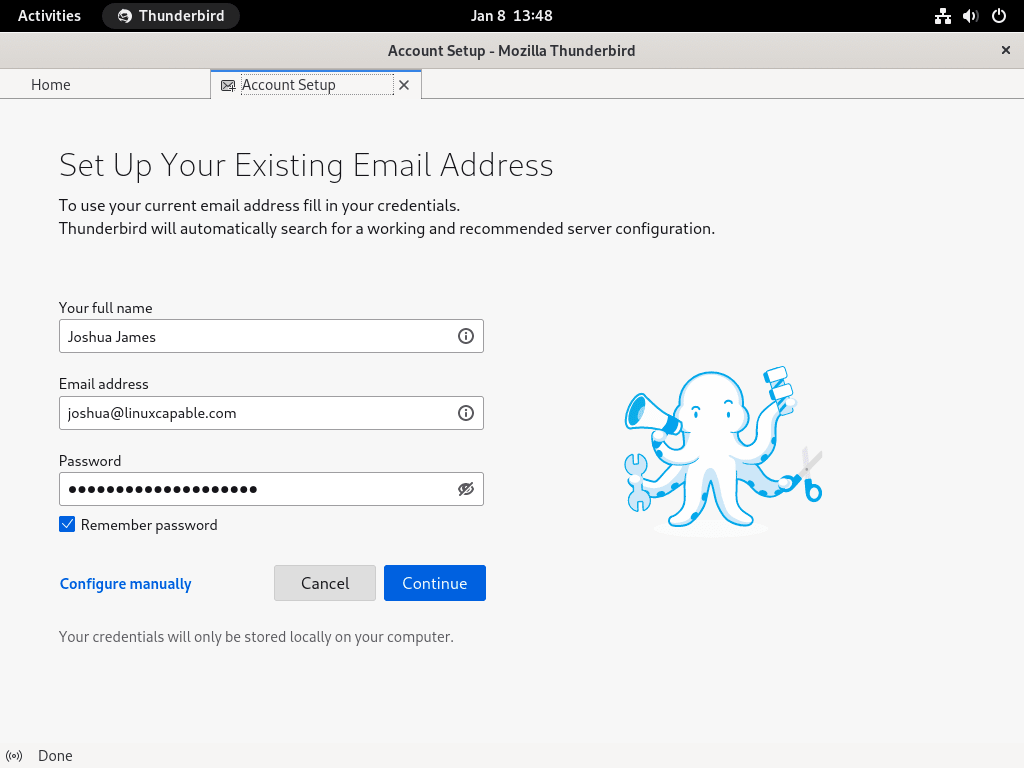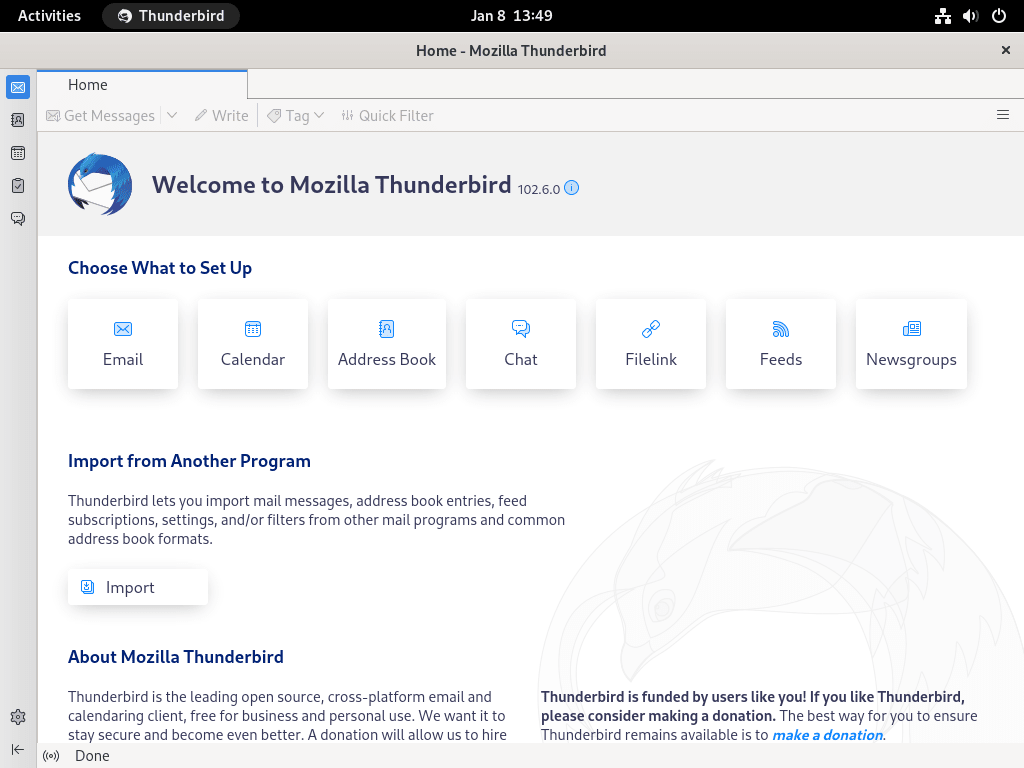Thunderbird is Mozilla’s free email client that handles multiple accounts, calendars, contacts, and newsgroups in a single interface. Whether you need to consolidate personal and work email, manage shared calendars with colleagues, or encrypt sensitive communications with OpenPGP, Thunderbird provides these capabilities without subscription fees or cloud dependencies. This guide walks through two installation methods on Fedora: the DNF package manager for system-integrated packages, and Flatpak for sandboxed installations with the latest upstream releases.
Choose Your Thunderbird Installation Method
Fedora offers two primary ways to install Thunderbird, each with different trade-offs for updates, integration, and isolation. The following table summarizes the key differences to help you decide which approach fits your needs.
| Method | Channel | Version | Updates | Best For |
|---|---|---|---|---|
| DNF Package Manager | Fedora Repos | Stable | Automatic via dnf upgrade | Most users who want system integration and distro-tested packages |
| Flatpak (Flathub) | Flathub | Latest stable | Automatic via flatpak update | Users who prefer sandboxed apps or need the newest features |
For most users, the DNF method is recommended because it integrates seamlessly with Fedora’s update system and requires no additional setup. However, if you prefer application sandboxing or want releases slightly ahead of Fedora’s packaging cycle, Flatpak provides a solid alternative.
Method 1: Install Thunderbird via DNF
The DNF package manager provides Thunderbird directly from Fedora’s official repositories. This method ensures the package receives security updates alongside your regular system upgrades.
Update Fedora System Packages
Before installing new software, refresh your package metadata and apply any pending updates. This step prevents dependency conflicts and ensures you install the latest available version.
sudo dnf upgrade --refreshInstall Thunderbird with DNF
Once your system is up to date, install Thunderbird with a single command. DNF automatically resolves and installs all required dependencies.
sudo dnf install thunderbirdVerify the Installation
After installation completes, confirm Thunderbird is accessible by checking its version. This step verifies the binary is correctly installed and available in your system PATH.
thunderbird --versionExpected output:
Mozilla Thunderbird 145.0
Your version number may differ depending on when you install. Thunderbird follows a rapid release cycle, so seeing a higher version indicates your installation succeeded with a newer release.
Method 2: Install Thunderbird via Flatpak
Flatpak provides Thunderbird in a sandboxed environment, isolating it from your system files. This approach offers several benefits: applications run with restricted permissions by default, updates come directly from Mozilla’s Flathub maintainers, and you can run different versions alongside the system package if needed.
Enable Flathub Repository
Fedora Workstation includes Flatpak by default, but the Flathub repository may not be enabled. First, add Flathub as a remote source. The --if-not-exists flag prevents errors if you have already configured it.
flatpak remote-add --if-not-exists flathub https://dl.flathub.org/repo/flathub.flatpakrepoYou can also enable Flathub through GNOME Software: open Software, go to the hamburger menu, select Software Repositories, and enable Flathub under Third-Party Repositories.
Install Thunderbird from Flathub
With Flathub enabled, install Thunderbird using the Flatpak command. The first installation may take longer as Flatpak downloads the required GNOME runtime if not already present on your system.
flatpak install flathub org.mozilla.ThunderbirdVerify the Flatpak Installation
After installation, confirm the application is registered correctly by checking its details. This command shows the installed version, branch, and origin repository.
flatpak info org.mozilla.ThunderbirdExpected output (version may vary):
Thunderbird - Thunderbird is a free and open source email, newsfeed, chat, and calendaring client
ID: org.mozilla.Thunderbird
Ref: app/org.mozilla.Thunderbird/x86_64/stable
Arch: x86_64
Branch: stable
Origin: flathub
Version: 145.0
Troubleshoot Flathub Connection Issues
If the installation fails with an error about a disabled remote, Flathub may be configured but not active. This commonly occurs when Flathub was added but later disabled.
error: Unable to load summary from remote flathub: Can't fetch summary from disabled remote 'flathub'
To resolve this issue, enable the Flathub remote and retry the installation:
flatpak remote-modify --enable flathubLaunch Thunderbird
With Thunderbird installed, you can launch it through the graphical interface or from a terminal session. Both methods work regardless of which installation method you used.
Launch from Applications Menu
For everyday use, the simplest approach is to search for Thunderbird in Activities. Press the Super key or click Activities in the top-left corner, then type “Thunderbird” in the search field and click the icon when it appears.

Launch from Terminal
If you installed via DNF, you can launch Thunderbird directly from any terminal:
thunderbirdFor Flatpak installations, use the Flatpak run command instead:
flatpak run org.mozilla.ThunderbirdFirst-Time Account Setup
When you first open Thunderbird, the setup wizard guides you through adding an email account. Enter your name, email address, and password. Thunderbird automatically detects IMAP/SMTP settings for most major email providers. If automatic configuration fails, click Configure manually to enter server details from your email provider’s documentation.

After completing the setup, Thunderbird displays your inbox and begins synchronizing messages. From here, you can add additional email accounts, configure calendars via CalDAV, or set up news feeds.

Manage Thunderbird
After installation, you will occasionally need to update Thunderbird or remove it entirely. The following commands cover both scenarios for each installation method.
Update Thunderbird
Keeping Thunderbird current ensures you receive security patches and new features. The update process differs depending on how you installed the application.
DNF installation: Thunderbird updates automatically when you run a system upgrade. You can also update it specifically:
sudo dnf upgrade --refresh thunderbirdFlatpak installation: Update all Flatpak applications, including Thunderbird:
flatpak updateRemove Thunderbird
If you no longer need Thunderbird, remove it along with any orphaned dependencies. Choose the command matching your installation method.
DNF installation:
sudo dnf remove thunderbirdFlatpak installation: The --delete-data flag removes the application’s sandboxed data directory:
flatpak uninstall --delete-data org.mozilla.ThunderbirdTo also remove unused Flatpak runtimes that were installed as dependencies:
flatpak uninstall --unusedWarning: Removing Thunderbird does not delete your local mail profile. Your emails, account settings, and address books remain in
~/.thunderbird/(DNF install) or~/.var/app/org.mozilla.Thunderbird/(Flatpak install). To completely remove all Thunderbird data, delete these directories after uninstalling the application. Back up important data first.
Conclusion
You now have Thunderbird installed and configured on Fedora, giving you a capable email client that handles multiple accounts, encrypted messaging, and calendar synchronization. The DNF method provides seamless system integration, while Flatpak offers sandboxing and faster access to new releases. Both approaches receive regular security updates, ensuring your email client remains secure as you manage your communications.


